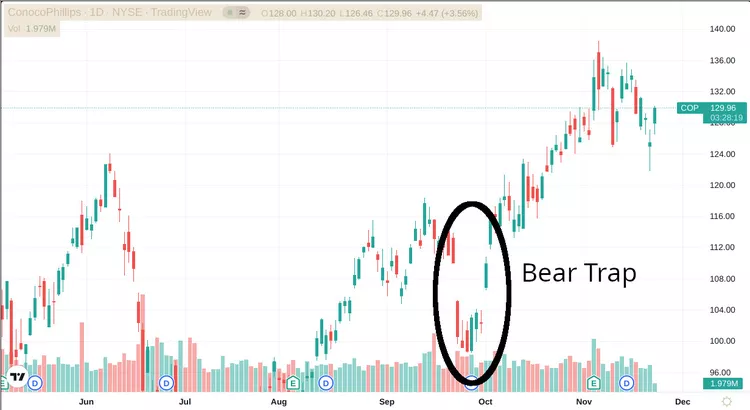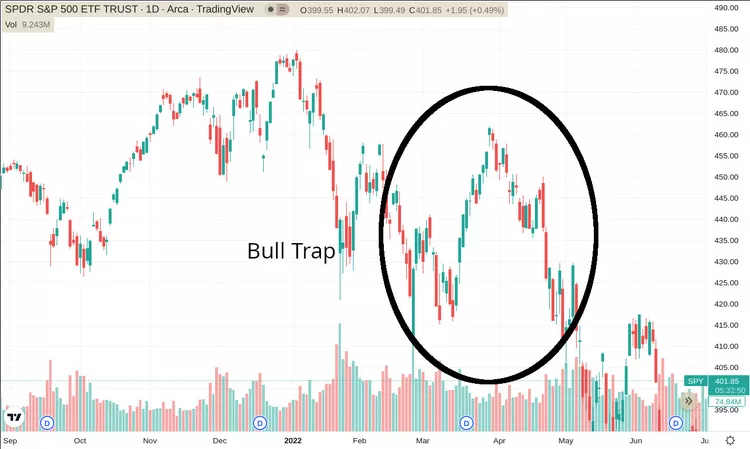What Is a Cryptocurrency Bear Trap?

In the volatile world of cryptocurrencies, investors and traders encounter various market situations that can impact their decision-making. One such scenario is a bear trap. Therefore, understanding what a bear trap is and how to avoid it is crucial for users, both beginners and experts alike.
This article fully explores the concept of bear traps, discusses how to identify and avoid them, and provides real-life examples to enhance your knowledge. And we cover everything using simple English – no technical jargon.
Bear Traps in Crypto Explained – The Summary
Read the main highlights from our guide if you’re short on time.
- Bear traps are deceptive market situations where the price appears to be declining, luring investors to sell, but suddenly reverses and traps those who sold at a lower price.
- Bear traps differ from bull traps, which involve a false breakout to the upside followed by a reversal.
- To identify bear traps, analyze volume and price patterns, looking for low volume during the decline and a sudden increase in buying pressure.
- Confirm with technical indicators like moving averages, trend lines, and the RSI to assess the trend’s strength and a potential bear trap.
- To avoid bear traps, stay informed about the market, utilize multiple time frames for analysis, and implement stop loss orders for risk management.
What Is a Bear Trap?
A bear trap refers to a deceptive market situation where the price of a cryptocurrency appears to be entering or continuing a downward trend, luring investors into selling their holdings or taking short positions.
But instead of further declining, the price suddenly reverses and starts moving upwards, trapping those who sold or shorted at a lower price. The sudden reversal catches these individuals off guard, forcing them to buy back at a higher price to cover their positions, resulting in losses or missed opportunities.
Bear Trap vs. Bull Trap
While a bear trap involves a false downward breakout followed by an upward reversal, a bull trap is the opposite. A bull trap occurs when the price of a cryptocurrency appears to be breaking out of a consolidation or resistance level, enticing investors to buy or take long positions.
However, the price quickly reverses and falls back into the consolidation range, trapping those who entered at higher prices.


How to Identify a Bear Trap
Identifying a bear trap involves analyzing various factors that indicate a potentially deceptive market situation. By carefully observing volume and price patterns and confirming with technical indicators, you can effectively increase your ability to identify bear traps.
Analyze Volume and Price Patterns
Determining a bear trap requires comprehensively analyzing the trading volume accompanying price movements. Typically, a bear trap occurs on low volume, indicating weak selling pressure. If you notice a decline in price on decreasing volume, it could be a sign of a bear trap in progress.
Confirm with Technical Indicators
Technical indicators can provide additional insights when identifying bear traps. Consider utilizing moving averages, trend lines, and oscillators like the Relative Strength Index (RSI). Moving averages can help identify the overall trend, while trend lines assist in spotting key support levels. The RSI can indicate whether a cryptocurrency is oversold or overbought, potentially signaling an imminent bear trap.
Avoiding Bear Traps
We recommend you stay well-informed about the cryptocurrency market to avoid bear traps. Furthermore, you must utilize different time frames for analysis and implement effective risk management strategies. Following these steps can help minimize the risk of falling into bear traps.
Stay Informed
To avoid bear traps, it’s crucial to stay informed about the cryptocurrency you are trading. Keep up with the latest news, announcements, and developments in the market. Major news events, regulatory changes, or shifts in market sentiment can trigger bear traps. Therefore, keep yourself up-to-date to anticipate potential market movements and avoid falling into bear traps caused by sudden fundamental changes.
Utilize Multiple Time Frames
Examining multiple time frames can provide a broader perspective on price movements and help avoid bear traps. For example, if a cryptocurrency appears in a bearish trend on a short-term chart, zooming out to a longer time frame might reveal a bullish trend. By considering different time frames, you can gain a comprehensive view of the market and avoid being misled by short-term price movements.
Implement Stop Loss Orders
One effective risk management strategy to mitigate potential losses during bear traps is to utilize stop-loss orders. Set a predetermined price level at which your position will automatically sell, thus limiting your downside risk. As a result, you can protect your capital and minimize losses if a bear trap occurs.
Real-Life Examples of Crypto Bear Traps
Bear trap examples from the real world can provide valuable insights into their occurrence and impact. These cases can enhance your understanding of bear traps and their potential consequences.
- In early 2021, Bitcoin experienced a significant price drop, causing panic among investors who sold their holdings. Shortly after, Bitcoin swiftly reversed its downtrend, resulting in a bear trap that caught many off guard.
- Ethereum Classic (ETC) experienced a significant bear trap in January 2019. Investors anticipated further decline as the price approached a critical support level and sold their ETC holdings or took short positions. However, unexpected positive news and developments, such as major exchange listings and partnerships, caused a sudden surge in buying pressure. This led to a rapid upward movement in the price, trapping those who had sold or shorted ETC. They were caught off guard by the shift in market sentiment and faced the choice of buying back ETC at higher prices or suffering losses.
FAQs
If you’re looking for more information, take a look at the answers to our readers’ most frequent questions.
Can bear traps only occur in cryptocurrencies?
No, bear traps can occur in various financial markets, including stocks, commodities, and cryptocurrencies.
How can I differentiate between a temporary price correction and a bear trap?
Temporary price corrections are a natural part of market cycles, while bear traps involve a false downward breakout followed by an upward reversal. Analyzing volume and price patterns and using technical indicators can help differentiate between the two.
Are bear traps intentional manipulations by market participants?
While large market players may intentionally create bear traps to manipulate prices, others occur naturally due to market dynamics and investor behavior.
How can I minimize the risk of falling into a bear trap?
You can reduce the risk of falling into bear traps by staying informed, conducting thorough analysis, using technical indicators, implementing stop loss orders, and considering multiple time frames.
What should I do if I suspect a bear trap is forming?
If you suspect a bear trap is forming, exercise caution and refrain from making impulsive trading decisions. Wait for confirmation signals, such as a significant increase in trading volume or the breach of a key resistance level, before adjusting your positions.
Bear Trap in Crypto Definition – Final Words
Understanding bear traps and the strategies to identify and avoid them is essential for cryptocurrency investors and traders. Moreover, analyzing volume and price patterns, confirming with indicators, staying informed, and implementing risk management allow you to better navigate the market.
Please note that cryptocurrency investments carry inherent risks, and it is essential to conduct thorough research and seek professional advice before engaging in any financial transactions.





